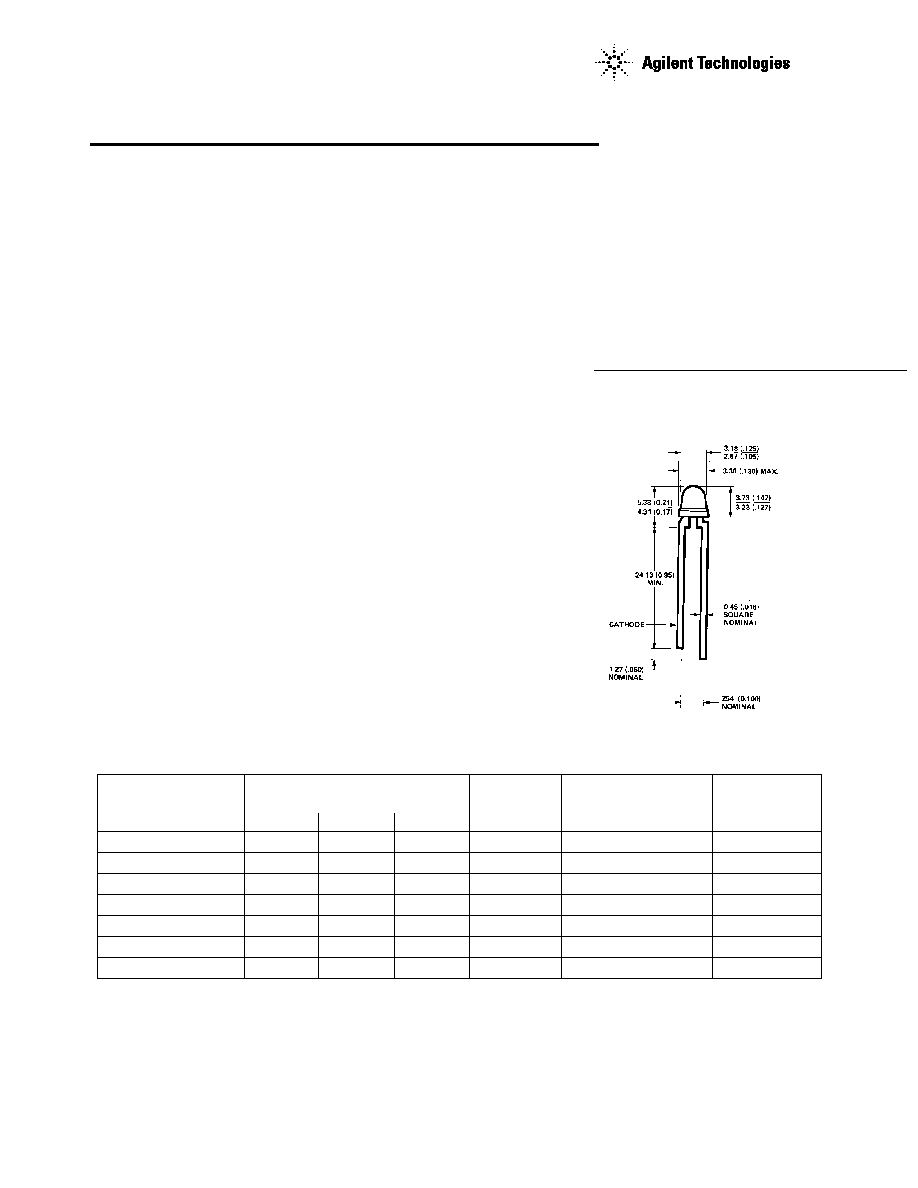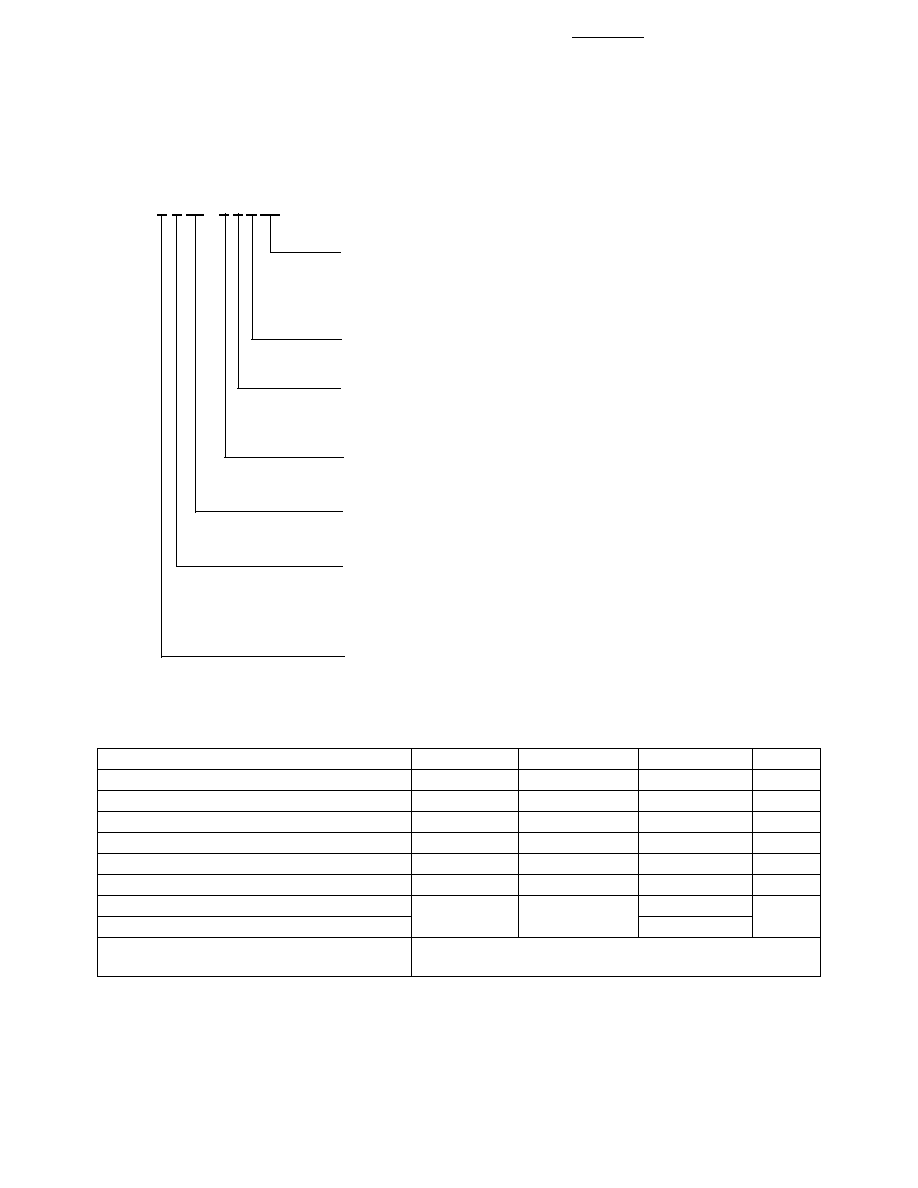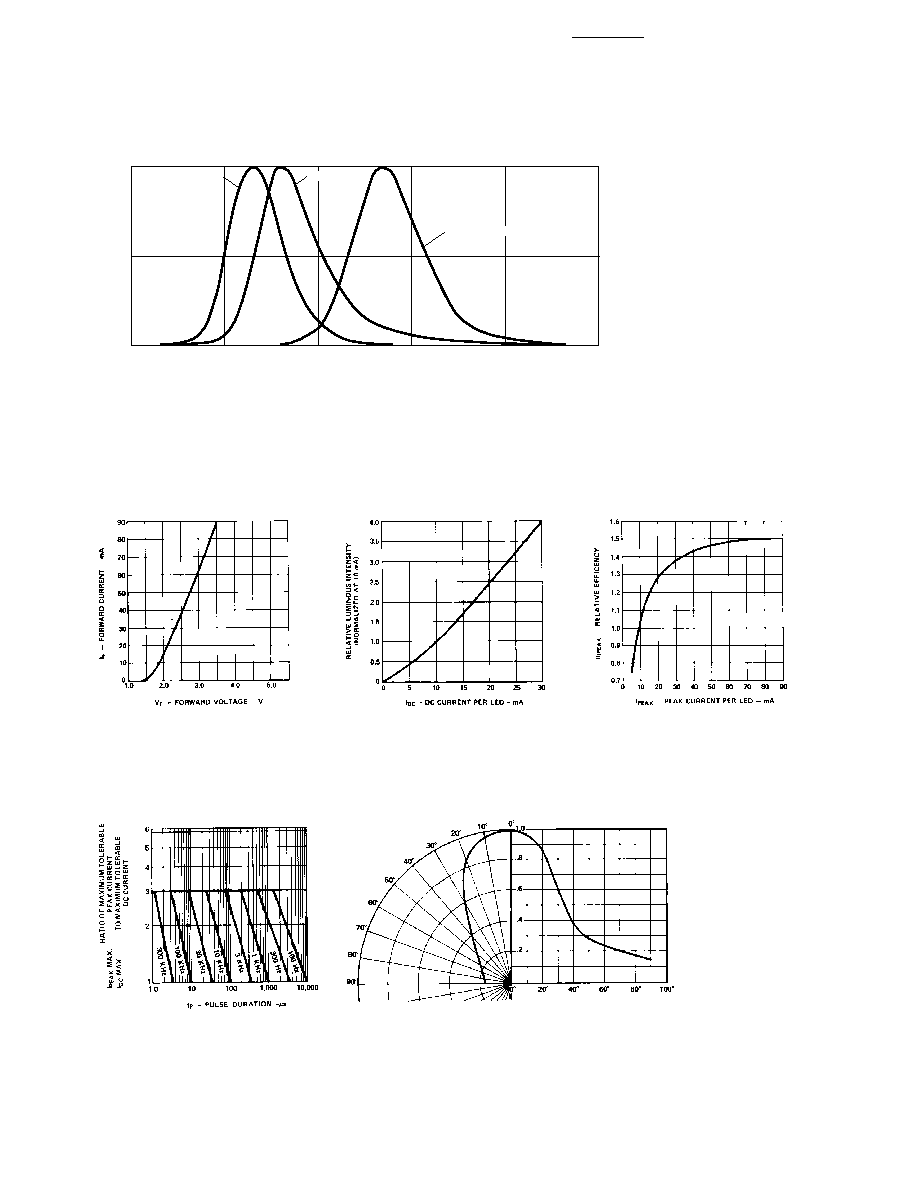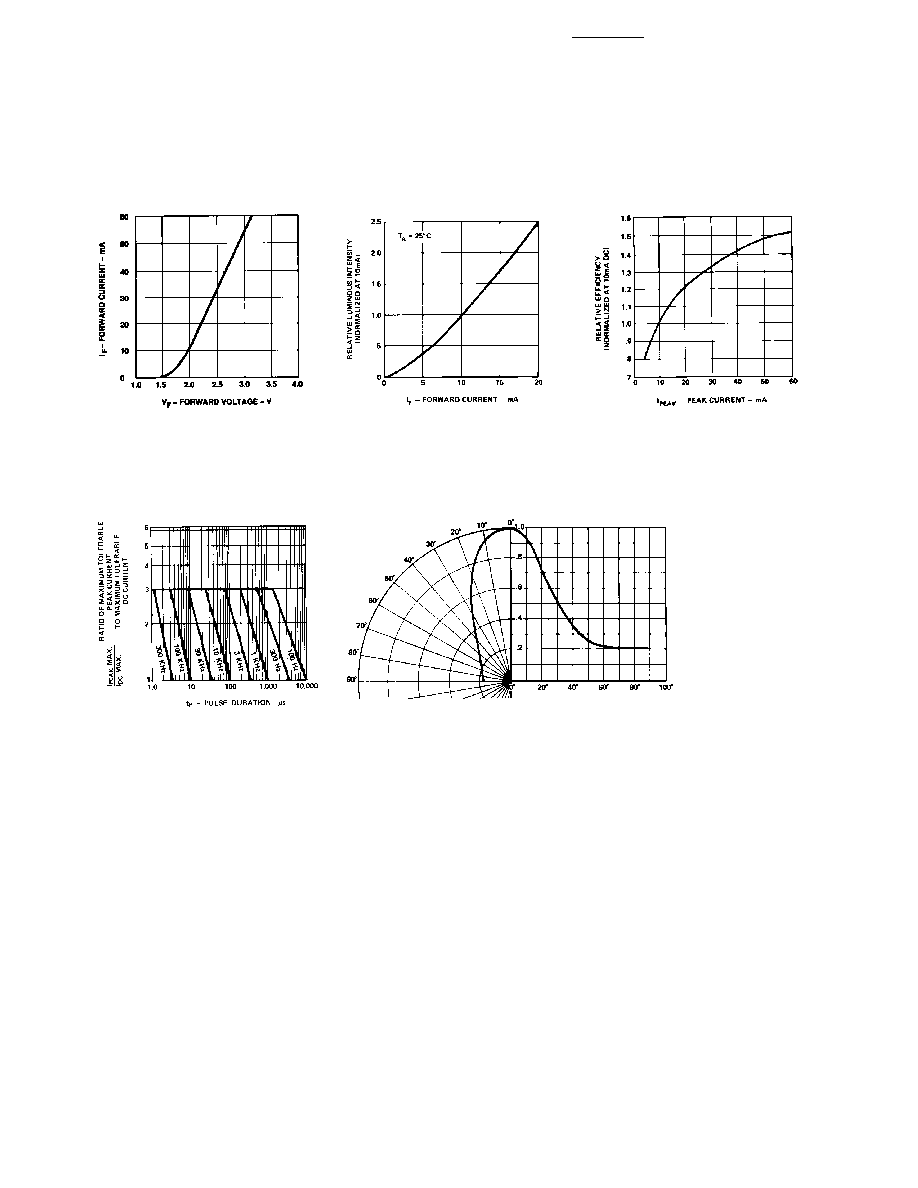
Low Profile T-1 (3 mm)
LED Lamps
Technical Data
Features
∑ Low Profile Height
∑ Small T-1 Size Diameter
3.18 mm (0.125 inch)
∑ High Intensity
∑ IC Compatible
∑ Choice of 3 Bright Colors
High Efficiency Red
Yellow
High Performance Green
Description
This family of diffused solid state
lamps is especially suited for
applications where small package
size is required without
sacrificing luminous intensity.
The HLMP-1350 is a red tinted
lamp providing a wide viewing
angle. The HLMP-1450 and
HLMP-1550 are similar products
in yellow and green respectively.
HLMP-1350
HLMP-1450
HLMP-1550
Package Dimensions
Selection Guide
Test
Typical Viewing
Luminous Intensity Iv (mcd)
Condition
Angle
[1]
(Degrees),
Dominant
Part Number
Min.
Typ.
Max.
(mA)
2
1/2
Wavelength
[2]
HLMP-1350
1.3
2.3
10.0
55
626
HLMP-1350-C00xx
1.3
2.3
10.0
55
626
HLMP-1450
1.4
2.2
10.0
55
585
HLMP-1450-B00xx
1.4
2.2
10.0
55
585
HLMP-1550
1.0
3.1
20.0
55
569
HLMP-1550-A00xx
1.0
3.1
20.0
55
569
HLMP-1550-BC0xx
1.6
2.8
5.2
20.0
55
569
Notes:
1.
1/2
is the off-axis angle at which the luminous intensity is half the axial intensity.
2. The dominant wavelength,
d
, is derived from the CIE chromaticity diagram and represents the single wavelength which defines the
color of the device.

2
Absolute Maximum Ratings
Parameter
HER
Yellow
Green
Units
Peak Forward Current
90
60
90
mA
Average Forward Current
25
20
25
mA
DC Current
30
20
30
mA
Reverse Voltage
5
5
5
V
Transient Forward Current (10
µ
sec Pulse)
500
500
500
µ
A
LED Junction Temperature
110
110
110
∞
C
Operating Temperature Range
-55 to +100
-55 to +100
-20 to +100
∞
C
Storage Temperature Range
-55 to +100
Lead Soldering Temperature
260
∞
C for
[1.6 mm (0.063 in.) from body]
5 Seconds
Notes:
1. See Figure 5 (HER/Orange), 10 (Yellow), or 15 (Green/Emerald Green) to establish pulsed operating conditions.
2. For Red, Orange, and Green series derate linearly from 50
∞
C at 0.5 mA/
∞
C. For Yellow series derate linearly from 50
∞
C at
0.2 mA/
∞
C.
3. For Red, Orange, and Green series derate power linearly from 25
∞
C at 1.8 mW/
∞
C. For Yellow series derate power linearly from
50
∞
C at 1.6 mW/
∞
C.
4. The transient peak current is the maximum nonrecurring peak current that can be applied to the device without damaging the LED
die and wirebond. It is not recommended that the device be operated at peak currents beyond the peak forward current listed in the
Absolute Maximum Ratings.
Part Numbering System
HLMP - x x xx - x x x xx
Mechanical Option
00: Bulk
01: Tape & Reel, Crimped Leads
02: Tape & Reel, Straight Leads
Color Bin Options
0: Full Color Bin Distribution
Maximum Iv Bin Options
0: Open (no max. limit)
Others: Please refer to the Iv Bin Table
Minimum Iv Bin Options
Please refer to the Iv Bin Table
Viewing Angle
50: 55 degrees
Color Options
3: GaP HER
4: GaP Yellow
5: GaP Green
Package Options
1: T-1 (3 mm)

3
Electrical Characteristics at T
A
= 25
∞
C
Device
Test
Symbol
Description
HLMP
Min.
Typ.
Max.
Units
Conditions
2
1/2
Included Angle Between Half
1350
55
Deg.
Note 1
Intensity Points
1450
55
1550
55
peak
Peak Wavelength
1350
635
nm
Note 2
1450
583
1550
565
d
Dominant Wavelength
1350
626
nm
1450
585
1550
569
1/2
Spectral Line Halfwidth
1350
40
nm
1450
36
1550
28
s
Speed of Response
1350
90
ns
1450
90
1550
500
C
Capacitance
1350
11
pF
V
F
= 0
1450
15
f = 1 MHz
1550
18
R
J-PIN
Thermal Resistance
1350
290
∞
C/W
Junction to
1450
Cathode
1550
Lead
V
F
Forward Voltage
1350
1.6
1.9
3.0
V
I
F
= 10 mA
1450
1.6
2.0
3.0
1550
1.6
2.1
3.0
V
R
Reverse Breakdown Voltage
1350
5.0
V
I
R
= 100
µ
A
1450
5.0
1550
5.0
v
Luminous Efficacy
1350
145
lumens/
Note 3
1450
500
Watt
1550
595
Notes:
1.
1/2
is the off-axis angle at which the luminous intensity is half the axial luminous intensity.
2. The dominant wavelength,
d
, is derived from the CIE chromaticity diagram and represents the single wavelength which defines the
color of the device.
3. Radiant intensity, I
e
, in watts/steradian, may be found from the equation I
e
= I
v
/
v
, where I
v
is the luminous intensity in candelas
and
v
is the luminous efficacy in lumens/watt.

4
High Efficiency Red HLMP-1350
Figure 2. Forward Current vs.
Forward Voltage Characteristics.
Figure 3. Relative Luminous Intensity
vs. DC Forward Current.
Figure 4. Relative Efficiency
(Luminous Intensity per Unit
Current) vs. Peak LED Current.
Figure 5. Maximum Tolerable Peak
Current vs. Pulse Duration. (I
DC
MAX
as per MAX Ratings)
Figure 6. Relative Luminous Intensity vs. Angular Displacement.
WAVELENGTH ≠ nm
RELATIVE INTENSITY
500
550
600
650
700
750
1.0
0.5
0
HIGH
PERFORMANCE
GREEN
HIGH EFFICIENCY RED
YELLOW
TA = 25 ∞C
Figure 1. Relative Intensity vs. Wavelength.

5
Yellow HLMP-1450
Figure 7. Forward Current vs.
Forward Voltage Characteristics.
Figure 8. Relative Luminous Intensity
vs. DC Forward Current.
Figure 9. Relative Efficiency
(Luminous Intensity per Unit
Current) vs. Peak Current.
Figure 10. Maximum Tolerable Peak
Current vs. Pulse Duration. (I
DC
MAX
as per MAX Ratings)
Figure 11. Relative Luminous Intensity vs. Angular Displacement.




